“Explorations in Felt” Reviewed by Patricia Malarcher
April 8, 2020
Explorations in Felt, organized by the Hunterdon Art Museum in partnership with the Fiber Art Network/Fiber Art Now (FAN), considers a versatile fibrous material from a wide-angle view. Drawing from a pool of submissions for a feature on felt in the print publication Fiber Art Now, the museum’s exhibition committee selected 28 works by an international group of 25 artists.
With no curatorial focus other than material, this convergence of creative practices includes standing and relief sculptures, mobiles, abstract and pictorial wall works, and vessels as well as art dolls portraying pop singers. Pieces vary in scale from Hyunsoo Kim’s postcard-size appliqué to a life-size pair of playful animals suggestive of a 3D still from an animated film. While clothing is the focus of many felt artists, Sugandha Gupta’s Sensory Textiles, evocative of a stockpile of snowballs, is the one wearable.
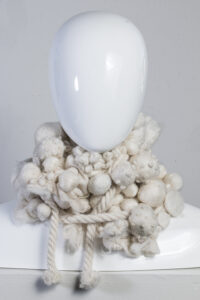
Sugandha Gupta Sensory Textiles 2017, wet felting, dry felting, hand embroidery, knitting, knotting, tying. Courtesy of the artist.
Among fiber processes, felt is uniquely adaptable to sculptural form through manipulation or molding. Common characteristics of wet felted fabric, for which wool fibers are beaten in soapy water until they bond, are dense, organically uneven surfaces. In Linda Brooks Hirschman’s Tree Skins: Settled, Revealed, Embraced and Chantal Cardinal’s Royal Leaf, these characteristics lend sculptural presence to woodsy botanical subjects. In Eva Camacho-Sanchez’s Border Scars, coarse felt in raw natural grays, horizontally split in a serpentine curve laced with porcupine quills, conveys the feeling of a menacing environment. Folded and gathered into a tumultuous surface, the felt in Kim Paxson’s Don’t Mess with Mother Nature reinforces the environmental threat depicted.
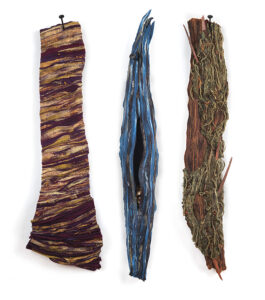
Linda Brooks Hirschman Tree Skins: Settled, Revealed, Embraced 2018, fiber, mixed media, 51” x 15” x 5”. Courtesy of the artist.
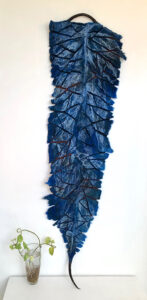
Chantal Cardinal Royal Leaf (FELT à la main with LO) 2019, locally sourced wool fleece, hand processed, hand dyed, wet felted, taped cracked design, felted cord, 8” x 21” x .5”. Courtesy of the artist.
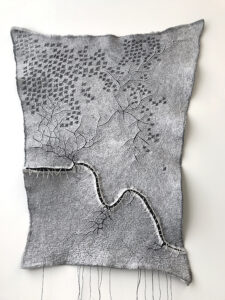
Eva Camacho-Sanchez Border Scars 2019, wet-felted merino wool, hand stitched, 35” x 25”. Courtesy of the artist.
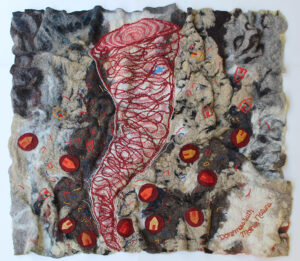
Kim Paxson Don’t Mess with Mother Nature 2019, felted wool, hand embroidered, Perle cotton thread, cotton-polyester backing, 38” x 38” x 1”. Courtesy of the artist.
In contrast, Pam MacGregor’s Tribal Totem, in which a feather-topped stack of oval and spherical forms rise from a nest-like container, stands out for its elegant details and whimsical stance.
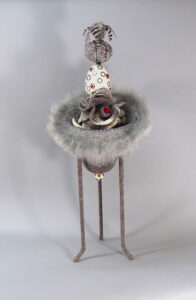
Pam MacGregor Tribal Totem 2018, felted wool, 25” x 11” x 12”. Courtesy of the artist.
As fibers adhere to each other in process, color becomes embedded in the felted surface. In Kim Buchheit’s Sacred Landscape, a tall lozenge-shaped panel, subtly blended colors form a painterly striated surface. In Speak Truth, Katherine McClelland combined needle-felting, which causes dry fibers to mat by stabbing them with a barbed needle, with wet felting. The black-on-black feminist text disappears into the background, but the message is clear in the artfully colored rendering of a woman in a pink “Pussy Hat.”
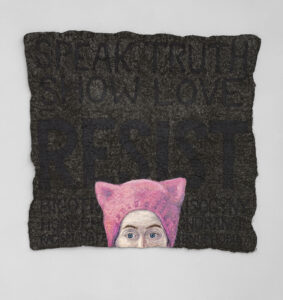
Katherine McClelland Speak Truth 2017, wet and needle felting, 30” x 29”. Courtesy of the artist.
Felt has an unassertive role as a substrate in Ellen Bakker’s Tree of Life, but impressively accommodates a large-scale print of leafless trees, clear and sharp in front and fading behind like ancestral memory. Bakker’s felt, a mix of silk and wool fibers, is notable for its smooth, even texture.
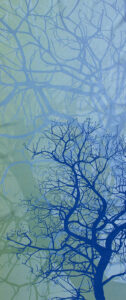
Ellen Bakker Tree of Life 2018, printed and felted chiffon silk and merino wool, 93” x 40”. Courtesy of the artist.
Jacobo Alonso’s innovative Augustus, built from 150 layers of thin gray felt stitched together, is greater than the sum of its parts. Each felt piece, a laser-cut shape, contributes to a form that develops as the units are piled in a designated sequence. The resulting work presents a series of faces resembling a stone carving with geological strata. Imagine a miniature mockup for a Mount Rushmore-style monument.
As a sampling of recent developments in felt, the exhibition is perhaps too eclectic to make a cohesive statement. Nevertheless, it leaves one assured that felt’s expressive possibilities are expanding and moving forward.
Explorations in Felt was on display at the Hunterdon Art Museum, Clinton, NJ January 17–April 19, 2020 (now temporarily closed due to covid-19). Click here for an online tour of the exhibition.
–Patricia Malarcher is an independent writer and studio artist as well as a former editor of Surface Design Journal. The American Council Fellow recently named her a 2020 Honorary Fellow.


3 Comments
Susan Lordi Marker says
April 8, 2020 at 7:11 am
I always enjoy ready Patricia’s reviews. Was fun and interesting to read about this expressive exploration of felt.
Kim Buchheit says
April 8, 2020 at 7:16 am
Very nice review. Thank you, Patricia!
melissa says
April 8, 2020 at 6:38 pm
go felters!
Related Blog Articles
No related blog articles yet.